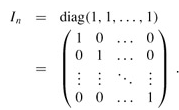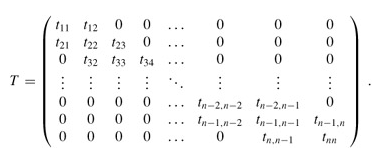Properties Of Matrices
Properties of matrices: In this section, we review some basic concepts of matrix theory and some fundamental properties of matrices, focusing on those that will be needed in later sections
Matrices and vectors: A matrix is a rectangular array of numbers. For example,

is a 2 × 3 matrix A = (aij), where for i = 1, 2 and j = 1, 2, 3, the element of the matrix in row i and column j is aij. We use uppercase letters to denote matrices and corresponding subscripted lowercase letters to denote their elements. The set of all m × n matrices with real-valued entries is denoted Rm×n. In general, the set of m × n matrices with entries drawn from a set S is denoted Sm×n.
The transpose of a matrix A is the matrix AT obtained by exchanging the rows and columns of A. For the matrix A of equation (28.1),

A vector is a one-dimensional array of numbers. For example,
![]()
is a vector of size 3. We use lowercase letters to denote vectors, and we denote the ith element of a size-n vector x by xi , for i = 1, 2, . . . , n. We take the standard form of a vector to be as a column vector equivalent to an n × 1 matrix; the corresponding row vector is obtained by taking the transpose:
xT = (2 3 5).
The unit vector ei is the vector whose ith element is 1 and all of whose other elements are 0. Usually, the size of a unit vector is clear from the context.
A zero matrix is a matrix whose every entry is 0. Such a matrix is often denoted 0, since the ambiguity between the number 0 and a matrix of 0's is usually easily resolved from context. If a matrix of 0's is intended, then the size of the matrix also needs to be derived from the context. Square n × n matrices arise frequently. Several special cases of square matrices are of particular interest:
-
A diagonal matrix has aij = 0 whenever i ≠ j. Because all of the off-diagonal elements are zero, the matrix can be specified by listing the elements along the diagonal:
-

-
The n × n identity matrix In is a diagonal matrix with 1's along the diagonal:
-

-
When I appears without a subscript, its size can be derived from context. The ith column of an identity matrix is the unit vector ei.
-
A tridiagonal matrix T is one for which tij = 0 if |i - j| > 1. Nonzero entries appear only on the main diagonal, immediately above the main diagonal (ti,i 1 for i = 1, 2, . . . , n - 1), or immediately below the main diagonal (ti 1,i for i = 1, 2, . . . , n - 1):
-
